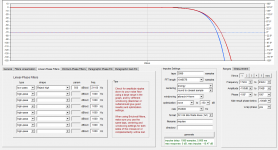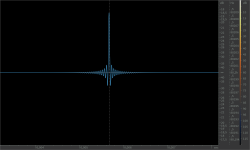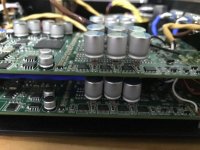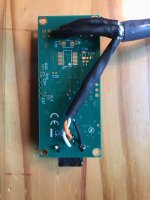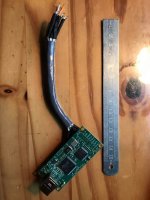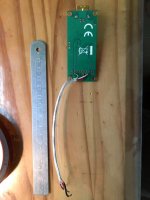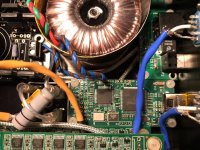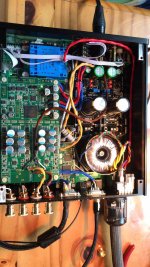hi bambadoo how did you use it any specific settings that you are following for the best performance?
Sorry I cannot be very specific right now but this is just an example using a linear fir filter
Attachments
Last edited:
You can try these:
2k taps firmware: https://www.diyaudio.com/forums/mul...on-eq-fir-filtering-tool-251.html#post5554133
4k taps firmware: https://www.diyaudio.com/forums/mul...on-eq-fir-filtering-tool-252.html#post5554217
brickwall filters and Albrecht windows are a good combination for this sort of task
2k taps firmware: https://www.diyaudio.com/forums/mul...on-eq-fir-filtering-tool-251.html#post5554133
4k taps firmware: https://www.diyaudio.com/forums/mul...on-eq-fir-filtering-tool-252.html#post5554217
brickwall filters and Albrecht windows are a good combination for this sort of task
Added the vref caps and fixed the SPDIF inputs in my build... Note that Chemi-Con 6.3V polymer caps have 0.8mm lead diameter so it's better to just get FPCAP/Nichicon or something with 0.6mm leads. Not worth it to trim 48 leads by hand...
The Amanero external power mod went well. Use lots of flux and high temperature (or be ready to wait 10sec for the solder on USB-B clamps to melt) and it's pretty straight-forward. I think it's worth it to keep Amanero always powered on and protected from USB power fluctuations. Don't use regular cables - go straight to UFL or cat6/cat7 ones if only for peace of mind. Makes sense to use cables specifically designed for high frequency transmissions. And don't get slightly cheaper Amanero knockoffs unless you know what you're doing...
Also moved the SE buffered out to the negative channel to keep SE and BAL outs independent. Tested DA101C and 25Mbps toslink receiver at 192Khz 24bits with no problem. I'm not sure if PE-65612NL could work at the highest sampling rate supported by dam1021 but it didn't make sense for me to procure an out-of-spec component.
It's nice to have ~5000uF of capacitors on each rail If you have the right caps it's an easy mod with low risk from my experience, at least for rev4/5. 1000uF per rail is most likely plenty, but 1500uF caps are cheap and performant....
If you have the right caps it's an easy mod with low risk from my experience, at least for rev4/5. 1000uF per rail is most likely plenty, but 1500uF caps are cheap and performant....
The Amanero external power mod went well. Use lots of flux and high temperature (or be ready to wait 10sec for the solder on USB-B clamps to melt) and it's pretty straight-forward. I think it's worth it to keep Amanero always powered on and protected from USB power fluctuations. Don't use regular cables - go straight to UFL or cat6/cat7 ones if only for peace of mind. Makes sense to use cables specifically designed for high frequency transmissions. And don't get slightly cheaper Amanero knockoffs unless you know what you're doing...
Also moved the SE buffered out to the negative channel to keep SE and BAL outs independent. Tested DA101C and 25Mbps toslink receiver at 192Khz 24bits with no problem. I'm not sure if PE-65612NL could work at the highest sampling rate supported by dam1021 but it didn't make sense for me to procure an out-of-spec component.
It's nice to have ~5000uF of capacitors on each rail
Attachments
Last edited:
[
Which rev are you using? I feel that I'm not getting everything out of my rev4 with no mods implemented, but Soren said many times that caps mods are no longer necessary. He did make paralleling electrolytic caps extremely easy with the vias though in the new versions though.
Hello,
Sorry for the goofy question, but I get confused about the caps mod...
With a rev 5 board, is it worth or not to do the caps mod?
Thanks
Hello,
Sorry for the goofy question, but I get confused about the caps mod...
With a rev 5 board, is it worth or not to do the caps mod?
Thanks
As said before, no modifications are needed on rev 2 to 5. But you can still add additional capacitance.
Industrial DACs are more about absolute precision, while the Sign Magnitude principle only really matters for Audio, and yes, the PCM1704 was the last Burr-Brown (later TI) Sign Magnitude DAC, too expensive to manufacture, so it got EOL'ed....
You can calibrate at any level, but more precision require more precise AD converter and more bits to store the results.... And you need to have the ADC onboard as you would need to calibrate at each power up.
A Sign Magnitude converter isn't that critical with absolute precision, we sell plenty of dam1021 uing 0.05% parts and they sound good anyway.
Digital Distortion Compensation for Measurement Setup ?
//
Added the vref caps and fixed the SPDIF inputs in my build... Note that Chemi-Con 6.3V polymer caps have 0.8mm lead diameter so it's better to just get FPCAP/Nichicon or something with 0.6mm leads. Not worth it to trim 48 leads by hand...
It's nice to have ~5000uF of capacitors on each railIf you have the right caps it's an easy mod with low risk from my experience, at least for rev4/5. 1000uF per rail is most likely plenty, but 1500uF caps are cheap and performant....
Getting interested in this capacitor mod. I only see 12 caps in the picture, but I thought there were sixteen shift registers?
What FPCAP would you suggest, NU series? So its 0.6 mm leads could directly fit in the Soekris PCB?
Anyhow, first I have to focus on the digital side of things. I plan to try separate 5V and 3.3V supplies to remove dependency on USB power for Amanero+isolators. Let's see whether this change is audible given all the reclocking in the STM32. So far I hear quite some differences between Asio, kernel streaming, Wasapi, 24/32 bit configurations and buffer sizes on PC side. This is puzzling me. I would like to be able to do an I2S capture (or even jitter measurements) to analyze this further. I doubt all configurations are bit perfect.
@Soekris
I would still appreciate greatly a feature in Soekris DAC to assess bit perfectness...
Fedde
I added one 8200 uf capacitor to each of the 4 rails (middle position) already equipped with 12 220 uf caps.
It made an obvious difference.There is more clarity, immediacy and solidity to the sound after the mod. I clearly noticed reverb trails that were masked before.
Still wonder what the ideal capacitance is. The 12 220uf caps already seemed excessive, but...
It made an obvious difference.There is more clarity, immediacy and solidity to the sound after the mod. I clearly noticed reverb trails that were masked before.
Still wonder what the ideal capacitance is. The 12 220uf caps already seemed excessive, but...
I added one 8200 uf capacitor to each of the 4 rails (middle position) already equipped with 12 220 uf caps.
It made an obvious difference.There is more clarity, immediacy and solidity to the sound after the mod. I clearly noticed reverb trails that were masked before.
Still wonder what the ideal capacitance is. The 12 220uf caps already seemed excessive, but...
I believe theoretically more is better and Soren said the rails are stable with any capacitance. Glad to hear you're getting better results! The measurements show a minimal but nonetheless visible improvement from 1000uF to 6600uF. Soren uses 1000uF in all his later products. My setup is probably as good as it can get due to physical limitations, and how expensive 1800uF caps are...
Hello,
Sorry for the goofy question, but I get confused about the caps mod...
With a rev 5 board, is it worth or not to do the caps mod?
Thanks
Living sounds uses rev5 and reported significant improvement by comparing recorded output before and after, however there's limited improvement in THD stats. The hifidrino blog compiled measurements and simulation results which showed that more is better. Rev4 and rev5 has 347uF per rail I believe.
Getting interested in this capacitor mod. I only see 12 caps in the picture, but I thought there were sixteen shift registers?
What FPCAP would you suggest, NU series? So its 0.6 mm leads could directly fit in the Soekris PCB?
FPCAP has 1800uF 6.3V 10*12.5 ones but they're harder to get, i.e. more expensive. If you have room, they also have 2200uF 20V in 10*20 package - shouldn't be too expensive if you can find the right vendors. 1500uF ones are much easier to find imo and FPCAP has them in 0.6mm leads I believe.
Caps on each rail are paralleled, 3 per rail is due to the vias Soren was able to provide on the PCB... Things are very tightly packed...
Anyhow, first I have to focus on the digital side of things. I plan to try separate 5V and 3.3V supplies to remove dependency on USB power for Amanero+isolators. Let's see whether this change is audible given all the reclocking in the STM32. So far I hear quite some differences between Asio, kernel streaming, Wasapi, 24/32 bit configurations and buffer sizes on PC side. This is puzzling me. I would like to be able to do an I2S capture (or even jitter measurements) to analyze this further. I doubt all configurations are bit perfect.
@Soekris
I would still appreciate greatly a feature in Soekris DAC to assess bit perfectness...
Fedde
Not sure if I hear any difference in output methods but modding Amanero to use external power supply is not difficult. You have many options - 3.3V/5V through USB pins/5V on L1...
Last edited:
In case it's useful to anyone, the caps on the top board measures ~36C and the resistor ladder measures ~40C, probably don't have to worry about the temperature imbalance that the caps introduce. On the other hand, long cap leads can have ESR comparable to that of the caps themselves...
Thanks Soren for the clarificationAs said before, no modifications are needed on rev 2 to 5. But you can still add additional capacitance.
Ok thank you for your feedback.Living sounds uses rev5 and reported significant improvement by comparing recorded output before and after, however there's limited improvement in THD stats. The hifidrino blog compiled measurements and simulation results which showed that more is better. Rev4 and rev5 has 347uF per rail I believe.
Other goofy questionmaybe:
Now looking at the way to do the cap mod, I wonder if it would not be easier to connect each lead of the cap directly to VCC/GND of the LVC595 rather than directly on the ceramic capacitor.
If you place your caps on say a 45 degree angle in relation to the via’s near the shift register VCC/GND, it should minimize extra length and allow both leads to be the same length.
Any advice on this?
Now looking at the way to do the cap mod, I wonder if it would not be easier to connect each lead of the cap directly to VCC/GND of the LVC595 rather than directly on the ceramic capacitor.
If you place your caps on say a 45 degree angle in relation to the via’s near the shift register VCC/GND, it should minimize extra length and allow both leads to be the same length.
You risk damaging the board, mechanical stability will be bad and there is nothing to be gained.
You risk damaging the board, mechanical stability will be bad and there is nothing to be gained.
OK, thanks, to be sure I’m clear I put a picture from a setup as discribed. Seems easier to solder...
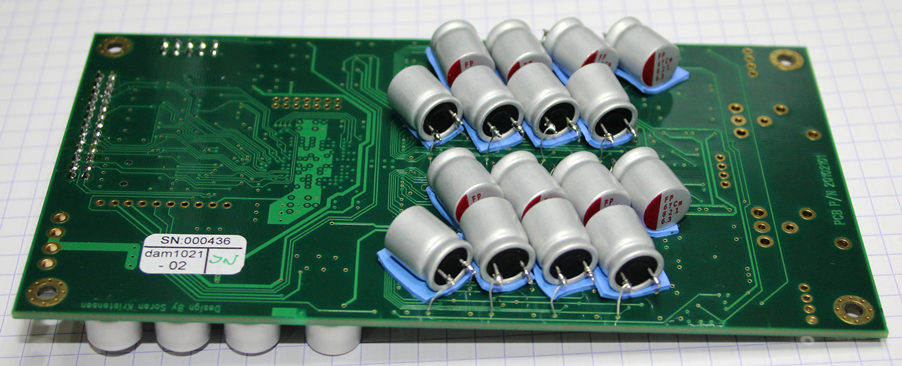
- Home
- Vendor's Bazaar
- Reference DAC Module - Discrete R-2R Sign Magnitude 24 bit 384 KHz
